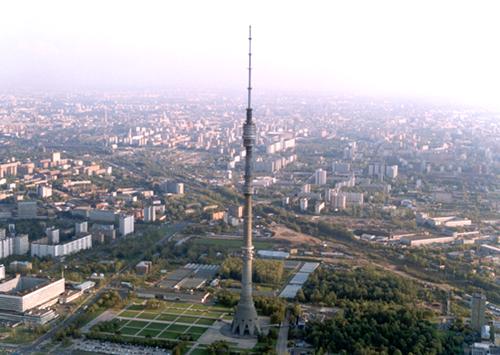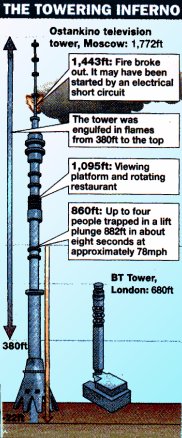
|
 |
|||||||||||||
FIRE AT OSTANKINO, MOSCOW
|
On Monday 28-Aug-2000 Russian firefighters extinguished the flames that ravaged the world's second highest tower and found the bodies of at least two people in an elevator that had crashed into the basement. By afternoon, nearly a day after the fire started, smoke had stopped billowing from inside Moscow's landmark Ostankino TV tower - twice the height of France's Eiffel Tower - but fears lingered that it could still collapse. By evening, fire officials said they had put out the blaze at the 540 metre (1772-foot) high tower, which was the tallest building on earth when it was built in 1967. Russian President Vladimir Putin, stung by criticism after he stayed on vacation when the Kursk submarine sank earlier this month, swung into action, convening his cabinet and telling them Russia had to revitalize its economy. "This latest accident shows the shape of our vital installations and the overall state of our country," he said. "We should not fail to see major problems in the country behind this accident, and we should not forget the economy. Whether or not such accidents happen again in the future will depend on how we work in this vital direction." The fire was the third disaster in Russia in a month, following an explosion in a Moscow underground passage that killed 12 people and the sinking of nuclear-powered submarine Kursk in the Barents Sea in which 118 died. |
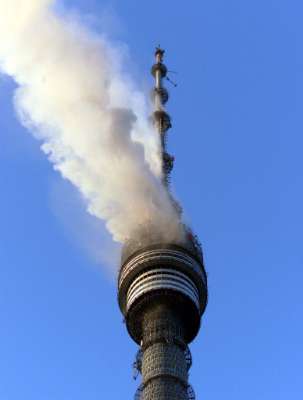 |
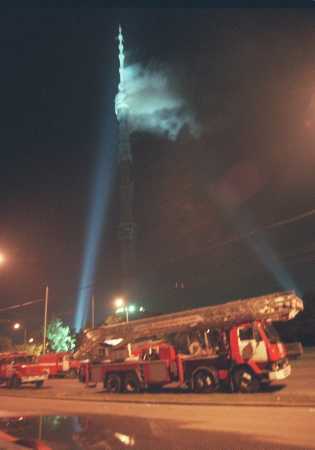 |
The Emergencies Ministry said two victims had been identified - senior firefighter Vladimir Artyukov, and elevator operator Svetlana Loseva. They had been trapped in a lift that crashed down into the waterlogged basement of the flaming spire. It was not clear if that would be the final death toll: earlier some officials had said up to two more firefighters might be missing. The elevator cabin was crushed under a massive counterweight, and officials could not say whether there were other bodies inside. The deaths again raised questions about Russia's ability to handle disasters after the failed rescue of the Kursk. A Moscow administration spokesman said the fire department violated rules by using the lift rather than the emergency stairs hours after the blaze broke out on Sunday. "Using the elevators during a fire is not allowed," he said. "It's not clear how they ended up in the lift even though it is a violation of regulations." Power went off when those in the elevator were on their way up to deliver supplies to firefighters, the fire brigade said Other possible safety violations came to light on Monday as firefighters discovered electricity still working in parts of the tower a day after power should have been shut off. Clocks at 147 metres high still gave the accurate time. |
Officials remained on alert against a collapse of the tower given damage from the intense heat. "Our prognosis is that everything will be fine and there will not be a collapse, that's our hope at present," Interior Ministry spokesman Yevgeny Ryabtsev told Reuters. Strong steel wires forming the skeleton of the structure had been weakened, however. "Today we know that some of the wires at 136 metres have developed considerable damage,'' Emergencies Minister Sergei Shoigu said at the scene. Spectators gathered to watch the effort from a safety perimeter maintained because of fears that the slender spire on top of the building might collapse. Moscow Mayor Yuri Luzhkov told reporters that the exclusion zone around the tower would remain in force throughout Monday. Flames had earlier engulfed the upper section of the tower from the top to well below its Seventh Heaven rotating restaurant, 334 metres (1095 feet) above the ground. The restaurant was evacuated soon after the fire broke out. RTR state television, briefly blacked out by the fire on Sunday, said a short circuit in banks of electrical equipment at the top of the tower probably ignited the blaze. |
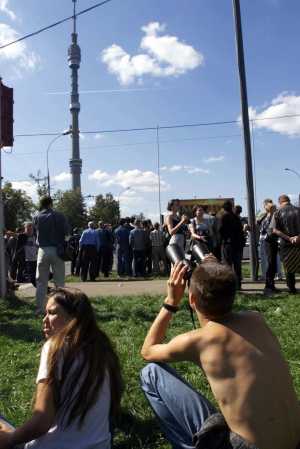 |
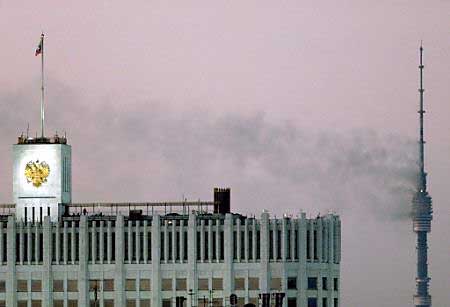 |
The building, surrounded by parkland in northern Moscow, contains radio and television transmitters. The Ostankino television studios with Russia's main TV stations are nearby. Three national television stations that use the tower as a relay station went off the air when the fire broke out. Transmissions to provinces were resumed by satellite later, but most of Moscow's 10 million viewers who do not have cable television saw white snow on their screens on Monday. By contrast, even during the turmoil of the 1991 and 1993 coups, television continued to broadcast. The Ostankino tower was completed in 1967 and heralded as a triumph of Soviet engineering. It lost its mantle as the world's tallest free-standing structure when Toronto's CN Tower, at 553 metres (1815 feet), was built. |
More dramatic pictures of the Ostankino fire:
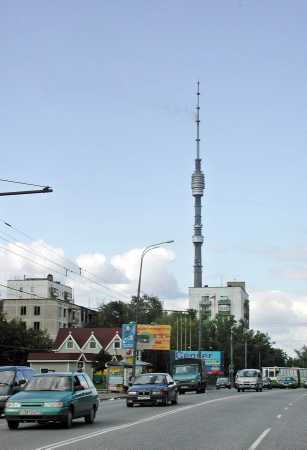 |
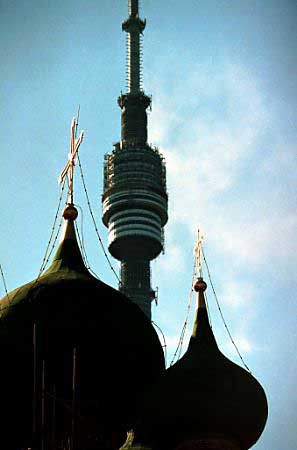 |
| Muscovites go about their daily business, most of them unaware that a drama is beginning to unfold above them | |
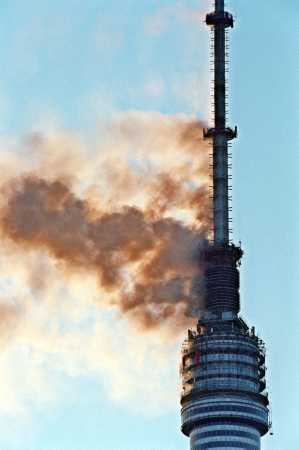 |
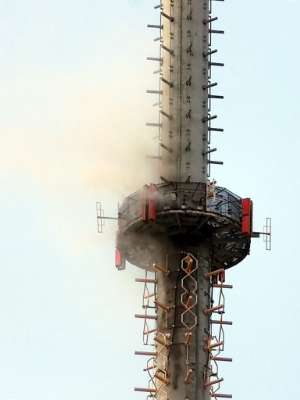 |
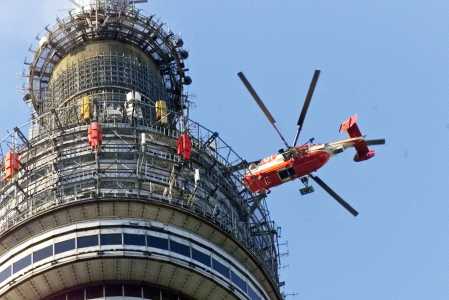 |
|
| Helicopters
are apparently unable to drop water onto the tower from above due to
the heat, and there is a shortage of 500m turntable ladders. |
|
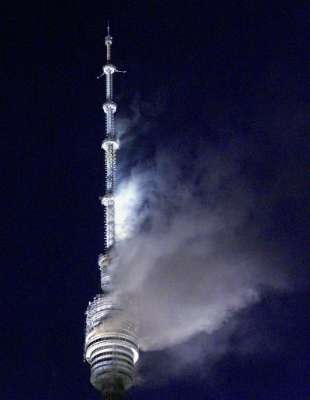 |
 |
| The fire burns through the night... | |
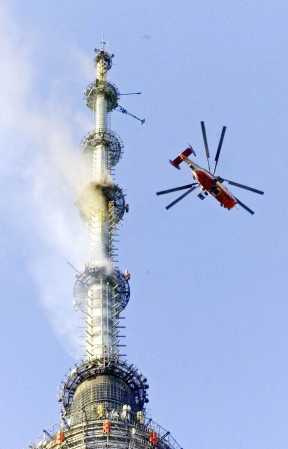 |
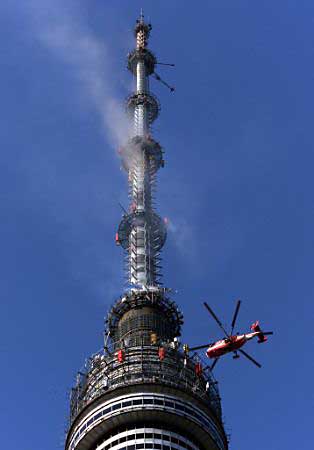 |
| ... and is finally extinguished the following day | |
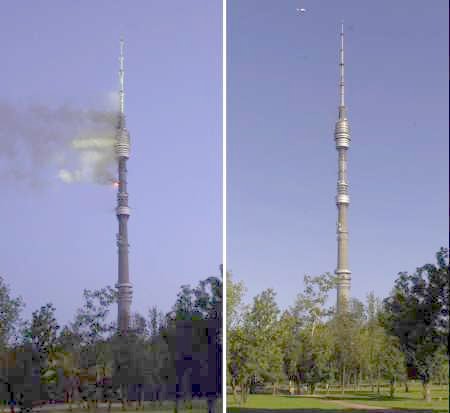 |
|
| During... | and after the fire |
Ostankino Television Tower | The Great Towers of the World
|
